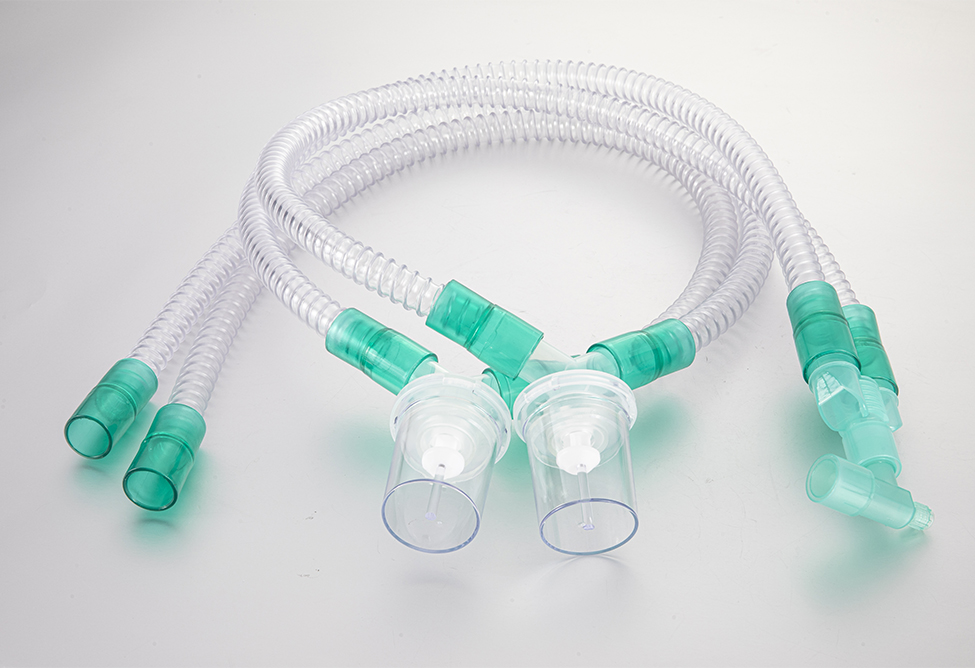What are the characteristics of the two circuits of the anesthesia breathing circuit?
Date:2022-02-09
The anesthesia breathing circuit is to form a circuit between the gas output port of the anesthesia machine and the patient's airway, which is called an anesthesia breathing circuit. Fresh gas and inhaled anesthetics are delivered into the patient's airway through the anesthesia breathing circuit, and the patient's exhaled gas is excluded from the body.
open system
The open system covers the anesthesia mask with a gauze sheet and places it on the patient's nose and mouth. After the anesthetic liquid is dripped on the gauze sheet to evaporate, it is inhaled by the patient with the air, and all the exhaled breath of the patient is discharged into the atmosphere through the gauze sheet .

half open circuit
Semi-closed or semi-open circuit: the part of the gas exhaled and inhaled by the patient is controlled by the anesthesia machine, and the exhaled gas can escape from the expiratory valve during exhalation. The amount of escaping gas depends on the resistance of the valve, but mainly depends on the flow of fresh air. When the flow of fresh gas is small, part of the exhaled gas (including CO2 and anesthetic gas) still remains in the breathing bag, which can be repeatedly inhaled by the patient during inspiration. When the fresh gas flow is less than the minute ventilation volume, and the repeated inhalation of CO2 is higher than 1% of the volume, it is called a semi-closed circuit; when the fresh gas flow is greater than the minute ventilation volume, and the repeated inhalation of CO2 is less than 1% of the volume, it is called a semi-open circuit.
closed loop
The exhaled and inhaled gas of the patient is completely controlled by the anesthesia machine, the exhaled gas enters the circuit and is inhaled by the patient when inhaling. Therefore, a CO2 absorber must be installed in the closed circuit, and the exhaled gas can only enter the inhalation passage after the CO2 is absorbed by the CO2 absorber. The fresh gas flow into the closed circuit is equal to the patient's oxygen consumption and nitrous oxide uptake. When the closed system is used, the flow of fresh air is the least, and the consumption of oxygen, nitrous oxide and inhalation anesthetics is also the least, and it is easier to ensure that the temperature and humidity of the inhaled gas are close to the physiological state. However, reliable CO2 absorbers, accurate oxygen concentration and anesthetic gas concentration monitors are necessary to ensure that patients will not suffer from hypoxia and CO2 retention during anesthesia.
open system
The open system covers the anesthesia mask with a gauze sheet and places it on the patient's nose and mouth. After the anesthetic liquid is dripped on the gauze sheet to evaporate, it is inhaled by the patient with the air, and all the exhaled breath of the patient is discharged into the atmosphere through the gauze sheet .

half open circuit
Semi-closed or semi-open circuit: the part of the gas exhaled and inhaled by the patient is controlled by the anesthesia machine, and the exhaled gas can escape from the expiratory valve during exhalation. The amount of escaping gas depends on the resistance of the valve, but mainly depends on the flow of fresh air. When the flow of fresh gas is small, part of the exhaled gas (including CO2 and anesthetic gas) still remains in the breathing bag, which can be repeatedly inhaled by the patient during inspiration. When the fresh gas flow is less than the minute ventilation volume, and the repeated inhalation of CO2 is higher than 1% of the volume, it is called a semi-closed circuit; when the fresh gas flow is greater than the minute ventilation volume, and the repeated inhalation of CO2 is less than 1% of the volume, it is called a semi-open circuit.
closed loop
The exhaled and inhaled gas of the patient is completely controlled by the anesthesia machine, the exhaled gas enters the circuit and is inhaled by the patient when inhaling. Therefore, a CO2 absorber must be installed in the closed circuit, and the exhaled gas can only enter the inhalation passage after the CO2 is absorbed by the CO2 absorber. The fresh gas flow into the closed circuit is equal to the patient's oxygen consumption and nitrous oxide uptake. When the closed system is used, the flow of fresh air is the least, and the consumption of oxygen, nitrous oxide and inhalation anesthetics is also the least, and it is easier to ensure that the temperature and humidity of the inhaled gas are close to the physiological state. However, reliable CO2 absorbers, accurate oxygen concentration and anesthetic gas concentration monitors are necessary to ensure that patients will not suffer from hypoxia and CO2 retention during anesthesia.


 简体中文
简体中文 English
English España
España












